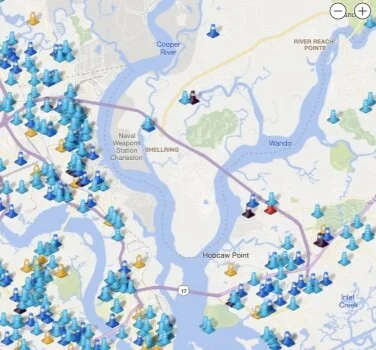Daniel Island Has A ‘Power-Ful’ Advantage When It Comes To Storm Resilience
ORIGINALLY PUBLISHED IN THE DANIEL ISLAND NEWS. WRITTEN BY: PAMELA BROWNSTEIN
This screenshot of power outages in the Lowcountry was taken from the Dominion Energy website during the height of Hurricane Dorian’s pounding of the coast on Sept. 4. The blue cones indicate reported power outages at the time. As the image reveals, Daniel Island proper did not lose power – a benefit of having underground power lines.
In 2006, during an announcement of the decision to bury the power lines running to Daniel Island from Mount Pleasant, former Charleston Mayor Joe Riley was quoted as saying, “All citizens of this community and the citizens of our city will benefit in all the years to come.”
It was a prophetic statement that rings true in the wake of Hurricane Dorian, since Daniel Island residents saw little impact from the storm in terms of losing power.
A screenshot from the website of Dominion Energy (formerly SCE&G) during the height of the storm on Sept. 4 shows multiple power outages in surrounding areas of Mount Pleasant, North Charleston, and parts of Clements Ferry Road, but none on Daniel Island.
“While every storm is different, and the impacts of the storm may vary across different parts of our service territory, there were no significant outages on Daniel Island in terms of number or duration during Hurricane Dorian,” said Dominion Energy Spokesperson Paul Fischer.
What protected the island against power outages?
In today’s marketplace, any neighborhoods that are being built are required to bury the power lines. According to Matt Sloan, president of the DI Development Company (formerly known as The Daniel Island Company), in most of these neighborhoods, the underground power lines usually tie to an above ground power station, making them still vulnerable to outages during a storm or natural disaster.
What sets Daniel Island apart is that there are power line feeds coming in from both North Charleston and Mount Pleasant. The lines from the island to Mount Pleasant run under the Wando River and are connected to a substation on Long Point Road. Having multiple feeds means that if something happens to the power in North Charleston, then the Mount Pleasant feed would keep the power in place.
The Retreat at Beresford, a neighborhood off Clements Ferry Road, did lose power during Dorian. Technicians from Texas-based Volt Power responded to assist Dominion Energy in restoring power to the community.
In addition, a third feed from Clements Ferry Road is in the process of being established, with new transmission lines to be built. The majority of that substation will also be underground. This will benefit neighborhoods along Clements Ferry Road, including Cainhoy Plantation, a master planned community in the early stages of development.
“The key for us is multiple feeds and, as much as possible, substations underground,” said Sloan, whose company is also managing the development at Cainhoy Plantation. “We’ve been able to put this (Daniel Island) community and the Cainhoy community in a better situation.”
When initially approached by SCE&G, Sloan said the development company was not on board with having overhead power lines that would run across the Wando River from Mount Pleasant onto Daniel Island. Typically, it is more expensive to bury power lines, but in this case, the developers were able to work collaboratively to make the project net neutral from an expense perspective for the utility company, by contributing property for the right of way. The DI Development Company was willing to forego economic return in order to have a more resilient and more aesthetically-pleasing power infrastructure, noted Sloan.
“The project was a highly collaborative effort between the developer and the company, which addressed the concern about cost shifts by the company and aesthetics by the developer,” stated Danny Kassis, vice president of customer relations and renewables at Dominion Energy. “Both parties wanted very reliable service and each had other items they needed to satisfy in their respective business models.”
In 2005, it took a joint effort between Daniel Island residents, the Daniel Island Neighborhood Association, the development company, the power company, and city leaders to make the challenge of installing underground power lines a reality.
“This was all designed with the goal of being resilient in times of natural disasters,” added Sloan.

